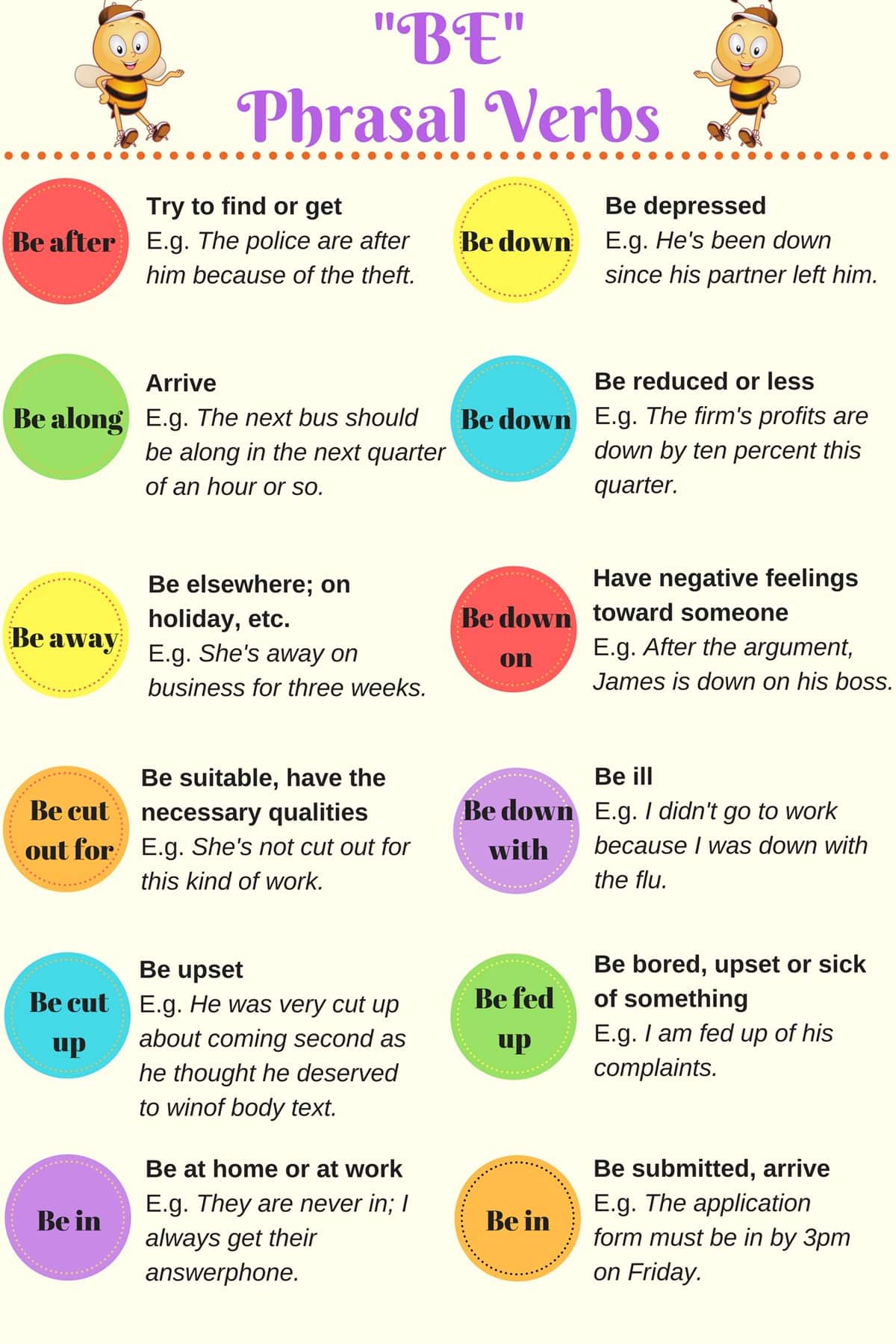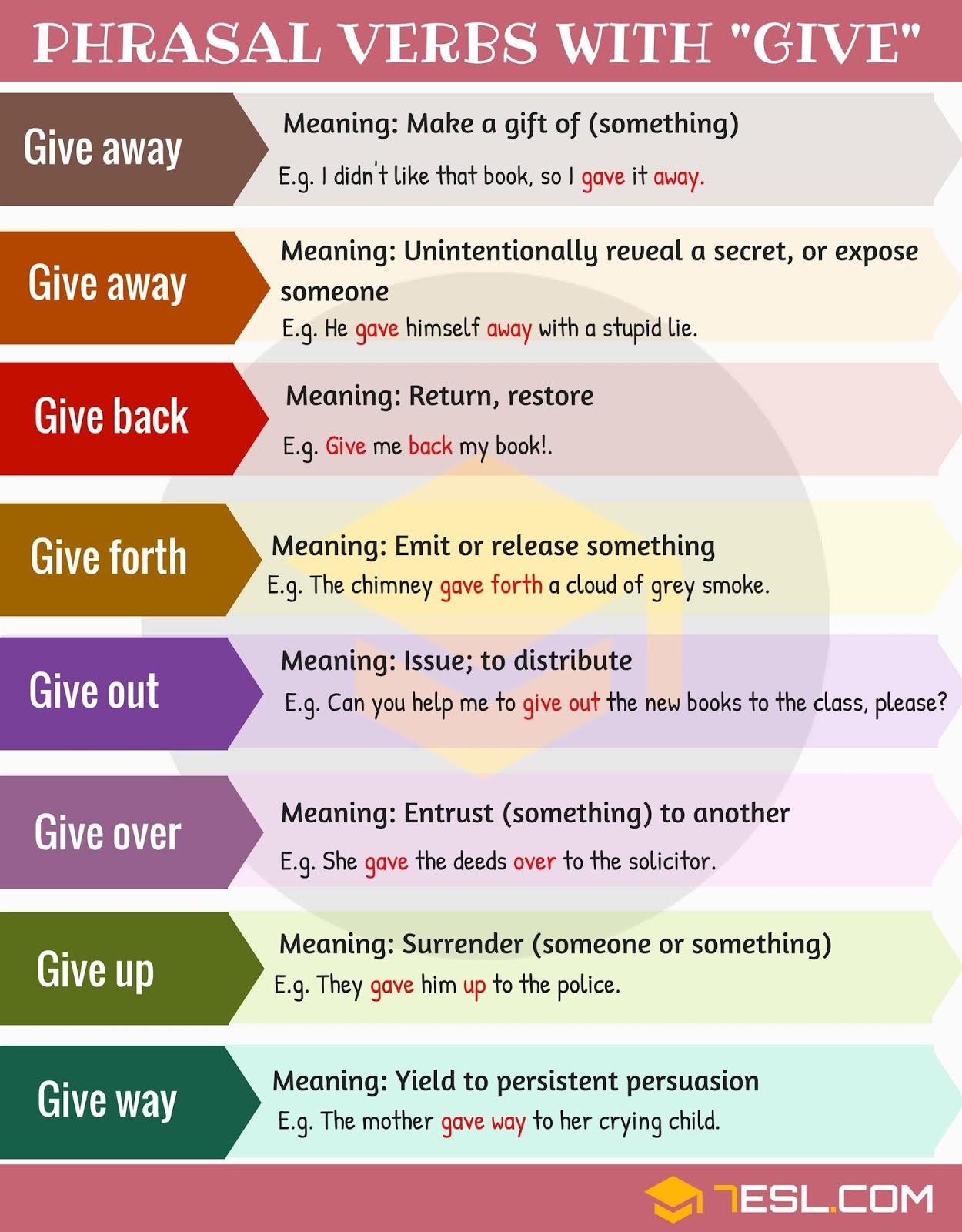Moreover, phrasal verbs can be intransitive -- not followed by a direct object – or transitive – followed by a direct object. Therefore, phrasal verbs can be separable, inseparable, transitive or intransitive . Verb + preposition When the element is a preposition, it is the head of a full prepositional phrase and the phrasal verb is thus prepositional. These phrasal verbs can also be thought of as transitive and non-separable; the complement follows the phrasal verb.a.
– after is a preposition that introduces the prepositional phrase after the kids.b. – on is a preposition that introduces the prepositional phrase on nobody.c. – into is a preposition that introduces the prepositional phrase into an old friend.d. – after is a preposition that introduces the prepositional phrase after her mother.e. – for is a preposition that introduces the prepositional phrase for a linguist.f.
These verbs can be transitive or intransitive. If they are transitive, they are separable.a. – up is a particle, not a preposition.b. – over is a particle, not a preposition.c. – down is a particle, not a preposition.d.
– in is a particle, not a preposition.e. – out is a particle, not a preposition.f. – in is a particle, not a preposition.Verb + particle + preposition (particle-prepositional verbs)Many phrasal verbs combine a particle and a preposition. Just as for prepositional verbs, particle-prepositional verbs are not separable.a.
– up is a particle and with is a preposition.b. – forward is a particle and to is a preposition.c. The other tanks were bearing down on my Panther.
– down is a particle and on is a preposition.d. They were really teeing off on me. – off is a particle and on is a preposition.e. – up is a particle and on is a prepositionf. Susan has been sitting in for me. – in is a particle and for is a preposition. The two categories have different values.
Particle-verb compounds in English are of ancient development, and are common to all Germanic languages, as well as to Indo-European languages in general. Those such as onset tend to retain older uses of the particles; in Old English on/an had a wider domain, which included areas now covered by at and in in English. Some such compound nouns have a corresponding phrasal verb but some do not, partly because of historical developments. The modern English verb+particle complex set on exists, but it means "start to attack" .
Verb-particle compounds are a more modern development in English, and focus more on the action expressed by the compound. That is to say, they are more overtly verbal. A complex aspect of phrasal verbs concerns the distinction between prepositional verbs and particle verbs that are transitive .
Particle verbs that are transitive allow some variability in word order, depending on the relative weight of the constituents involved. Shifting often occurs when the object is very light, e.g. Phrasal verb.1 She looked his address up. Phrasal verb.2 When he heard the crash, he looked up.
Not a phrasal verb.2 When he heard the crash, he looked up at the sky. Not a phrasal verb.The terminology used to denote the particle is also inconsistent. Sometimes it is called an adverb and at other times an intransitive prepositional phrase.
The inconsistent use of terminology in these areas is a source of confusion over what qualifies as a phrasal verb and the status of the particle or a preposition. The terminology of phrasal verbs is inconsistent. Modern theories of syntax tend to use the term phrasal verb to denote particle verbs only; they do not view prepositional verbs as phrasal verbs. In contrast, literature in English as a second or foreign language ESL/EFL, tends to employ the term phrasal verb to encompass both prepositional and particle verbs. In all these combinations, the added semantic value, if any, derives from metaphoric or metonymic interpretation of the complement, not from the preposition. Separable phrasal verbs follow different rules, however.
For starters, separable phrasal verbs are always transitive, so they always have a direct object. Very often, the same metaphorical idea occurs in many different words and phrases, not just in phrasal verbs. For example, the idea of moving upwards or of being in a high position is found in many words that metaphorically describe increases in quantity , and similarly with the opposite ideas . These are called 'conceptual' metaphors, and they are the subject of Metaphors We Live By by George Lakoff and Mark Johnson.
In this book, they demonstrate the importance of metaphor in relation to how we think and how we choose words to express our thoughts. Although phrasal verbs are acceptable in spoken English, they are frequently considered too informal for academic writing. Furthermore, phrasal verbs often have multiple meanings. Your aim is to write your paper in a simple language that makes your work clear and concise. It is therefore recommended that you replace phrasal verbs with formal one-word alternatives.
In this category, the verb retains its basic concrete meaning while the short adverb or preposition maintains a literal meaning . Such combinations are the easiest for language learners to understand and learn. The problem with phrasal verbs lies in their second element which is, for reasons that I do not find very clear, most of the times called a PARTICLE. According to some, a particle can be either a preposition or an adverb. If we believe others, it can only be an adverb (The verb+ preposition compounds are then simply called prepositional verbs).
A phrasal verb is usually a verb plus a preposition that we use in a different context than the verb's original meaning. For example, did you know that "to carry a tune" means to sing well? To "carry" literally means to move something while supporting it, but it can mean different things when used in phrasal verbs.
In this lesson, you will learn what it means to "carry out your tasks", "carry on" in class or at work, "get carried away", and more. In this lesson, you will learn a list of common phrasal verbs with CARRY in English with meaning and examples with ESL infographic. A phrasal verb is usually a verb plus a preposition that we use in a different context than the verb's original meaning.
For example, did you know that to carry a tune means to sing well? To carry literally means to move something while supporting it, but it can mean different things when used in phrasal verbs. In this lesson, you will learn what it means to carry out your tasks, carry on in class or at work, get carried away, and more. We think of problems and difficulties as if they are physical objects that get in our way. Some phrasal verbs have meanings to do with ignoring problems or behaving as if they do not exist. The metaphorical idea is that we go around or over the things that are in our way, or we push them farther away.
Think whether your own language has words and expressions with similar metaphorical ideas to those that we describe in the following sections. The meanings of phrasal verbs are often difficult to remember, because they seem to have no connection with the words that they consist of . In fact many phrasal verbs are metaphorical, and if you understand the metaphors they use, it will be easier to understand and remember their meanings. This article looks at ways in which different phrasal verbs share similar metaphors. One should consider in this regard that the actual term phrasal verb suggests that such constructions should form phrases.
In most cases however, they clearly do not form phrases. Hence the very term phrasal verb is misleading and a source of confusion, which has motivated some to reject the term outright. When a particle verb is transitive, it can look just like a prepositional verb. This similarity is source of confusion, since it obscures the difference between prepositional and particle verbs.
A simple diagnostic distinguishes between the , however. When the object of a particle verb is a definite pronoun, it can and usually does precede the particle. In contrast, the object of a preposition can never precede the preposition. Here is an alphabetical list of frequently used phrasal verbs with definitions and examples. In cases where the phrasal verb can be either separated or used as a single unit, examples are given of both forms.
The meaning of the phrasal verbs is often very different from the meanings of the two words taken separately. In order to understand the meaning of a phrasal verb, you may have to refer to the dictionary. Now you know more about transitive and intransitive verbs, start paying attention to them when you study. When you meet a new phrasal verb, make a note of whether it's transitive or intransitive so you know if you can separate the verb or not. And make your own examples too to help you remember them more easily. As a student of English, some of the things you need to learn are phrasal verbs.
And when you learn them, it's very helpful to know if they are transitive or intransitive. When one person has power and controls another, we think of the first person as being in a higher position than the second. Some phrasal verbs with over and up express ideas of someone being in control, or becoming more powerful than someone else. Below is the list of 10+ phrasal verbs with carry with meaning and example sentences.
Some phrasal verbs with out and up express ideas of revealing secrets or finding information, as if they are uncovered or brought to the surface. A few phrasal verbs with off refer to a new relationship between two people. The metaphorical idea is that the two people come together and become separate from a larger group. Metaphors relating to time are often based on the idea that time is like a line that goes from the past to the future, with the past behind us and the future in front of us. Phrasal verbs with ahead and forward express ideas of the future, while phrasal verbs with back and behind express ideas of the past.
You may have noticed that our phrasal verbs – and the noun spring, the season – carry or suggest the idea of a beginning, growth, movement or change. There are at least three main types of phrasal verb constructions depending on whether the verb combines with a preposition, a particle, or both. The phrasal verb constructions in the following examples are in bold. Like the short adverbs, most prepositions of this VPO category add a nuance to the meaning of the verb. Some, however, may serve merely as an empty connector between the verb and its object.
What is the phrasal verb of carry on If one admits that there is a separability issue, I suggest the question be reversed. I propose to consider that phrasal verbs evolve from an original separate stage, through a non-separate one, to eventually become unseparable combinations, not the other way round. If the object is a pronoun, it must be placed in the middle of a phrasal verb.
Pronoun direct objects cannot go at the end. On the other hand, sometimes it doesn't matter whether the direct object comes in the middle or at the end of a phrasal verb. Unfortunately, there's no method for knowing whether or not you have to separate a phrasal verb; you just have to study and practice until it comes naturally. Up." There are, however, a few rules to follow with separable phrasal verbs, so pay attention to our next section about word order. The following is a list of commonly deployed phrasal verbs that find one use or another in academic texts.
These can be acceptably used in academic texts. Along with these examples, however, are a number of one-word substitutions to illustrate that in each case the phrasal verb can be easily replaced. Using Storyboard That you can prepare a visual dictionary of phrasal verbs quickly and easily. Even better than that, have your students create their own phrasal verb visual definitions. Making progress and achieving things is like being on a journey and moving towards your destination. Phrasal verbs with along describe the kind of progress that is being made, while phrasal verbs with ahead and behind express ideas of making good progress or poor progress.
Before we begin, a word about phrasal verbs. Phrasal verbs have a verb and one or more short words linked to it. The verb and short word act together to take on a new meaning. They mean something different from what the individual words suggest.
No part of the meaning of the combination is predictable from the meanings of the verb and the short adverb or the preposition. Inseparable phrasal verbs cannot be split up and must be used together. To help simplify this complicated issue, what follows is our guide to understanding English phrasal verbs, including a list of the most common ones. Popular in spoken English, phrasal verbs can be quite confusing because their definitions aren't always easy to guess—and there are thousands of them. In fact, many phrasal verbs are distinct variations on the same base verb, which can add to the confusion.
You can download a table of phrasal verbs with carry below. We think of activities as if they have physical dimensions, like areas or spaces. In phrasal verbs, in and into express the idea of getting involved, while away and out express the idea of avoiding or ending an involvement. Sections 1 to 12 below explain some of the main conceptual metaphors that occur in groups of phrasal verbs. This idea is important as we explore phrasal verbs with "spring" in them.




























